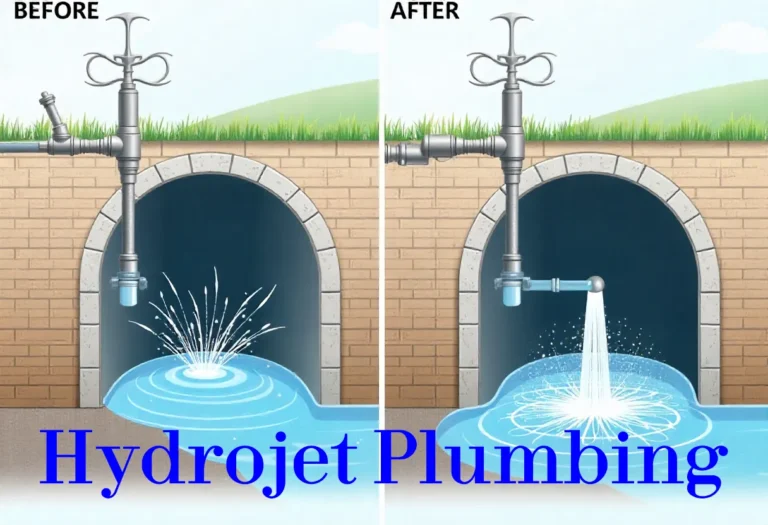You’ve tried the plunger. You’ve poured drain cleaner down the sink. Nothing works. Your pipes are still clogged, and water backs up every time you run the dishwasher. This is where hydrojet plumbing comes in.
Hydrojet plumbing uses high-pressure water jets to blast away stubborn clogs and buildup inside your pipes. It’s more powerful than traditional snaking and safer than chemical drain cleaners. Think of it as a pressure washer for your plumbing system.
This guide covers everything you need to know about hydrojet plumbing. You’ll learn how it works, what it costs, when you need it, and why professional plumbers recommend it for serious drain problems.
What Is Hydrojet Plumbing?
Hydrojet plumbing is a drain cleaning method that uses water pressure to clear blockages. The process blasts away buildup, debris, and even tree roots from your plumbing system. A specialized machine sends water through your pipes at pressures ranging from 3,000 to 8,000 PSI.
The equipment consists of three main parts. A water tank holds the supply. A high-pressure pump creates the force. A specialized nozzle directs the water jets in multiple directions. The nozzle moves through your pipes, scrubbing the walls clean as it goes.
This intense cleaning helps prevent the likelihood of future clogs by removing grease, soap scum, mineral deposits, and other materials that stick to pipe walls. Unlike traditional snaking, which only pokes a hole through a clog, hydrojetting removes the entire blockage.
How It Differs From Traditional Methods
Traditional drain snakes push through clogs but leave residue on pipe walls. Chemical drain cleaners can damage pipes and harm the environment. Hydrojet plumbing solves both problems.
The high-pressure water removes 100% of blockages without harsh chemicals. It cleans the entire pipe diameter, not just the center. This thorough approach means your drains stay clear longer.
When You Need Hydrojet Plumbing
Several warning signs indicate you need hydrojetting services. Recognizing these symptoms early can save you from costly repairs later.
Recurring clogs are the biggest red flag. If you clear a drain only to have it clog again within weeks, buildup has accumulated on your pipe walls. Standard methods can’t fix this problem.
Multiple slow drains throughout your home suggest a main line issue. When several fixtures drain slowly at once, the problem lies deeper in your system. Hydrojetting can clear main sewer lines effectively.
Foul odors coming from drains mean organic matter is decomposing inside your pipes. Bacteria feed on grease and food particles, creating unpleasant smells. Water jets eliminate these deposits completely.
Other situations that call for hydrojetting include:
- Tree root intrusion in sewer lines
- Grease buildup in restaurant drains
- Mineral scale in hard water areas
- Pre-purchase home inspections
- Regular maintenance for older homes
Warning Signs Table
| Symptom | Possible Cause | Solution |
|---|---|---|
| Water backing up in multiple fixtures | Main sewer line blockage | Hydrojet entire line |
| Gurgling sounds from drains | Partial obstruction creating air pockets | Professional inspection and jetting |
| Sewage odor in yard | Cracked pipe or severe blockage | Camera inspection plus hydrojetting |
| Slow drainage despite snaking | Pipe wall buildup | Complete hydrojet cleaning |
The Hydrojetting Process
Professional plumbers follow a systematic approach to hydrojet plumbing. Understanding these steps helps you know what to expect.
Step 1: Video Inspection
Plumbers insert a camera into your pipes first. This reveals the location and severity of clogs. It also checks for damaged pipes that can’t withstand high pressure.
Step 2: Access Point Selection
Technicians identify the best entry point for the equipment. This is usually a cleanout valve or drain opening. Proper access ensures thorough cleaning.
Step 3: Equipment Setup
The hydrojetting machine connects to a water source. Plumbers select the appropriate nozzle based on your specific problem. Different nozzles handle different types of blockages.
Step 4: Jetting Process
Water blasts through the pipes at controlled pressure. The nozzle pulls itself through the line, propelled by rear-facing jets. Forward-facing jets break up clogs and scour pipe walls.
Step 5: Final Inspection
Another camera check confirms the cleaning worked. Plumbers verify all debris has been removed and water flows freely.
The entire process typically takes two to three hours for residential properties. Commercial jobs may require more time depending on system size.
How Much Does Hydrojet Plumbing Cost?
Hydrojetting a sewer line typically costs between $300 and $600 for most residential jobs. However, prices vary based on several factors.
Location affects pricing significantly. Urban areas with higher labor costs charge more than rural regions. The typical price usually runs somewhere between $850 and $1,300 depending on the scope and severity of the clog.
Severity of the blockage impacts cost. Simple grease clogs cost less than tree root removal. Plumbers charge more for extensive buildup requiring multiple passes.
Accessibility matters too. Easy-to-reach cleanouts reduce labor time. Hard-to-access pipes require more work and higher fees.
Pipe length increases expense. Longer sewer lines need more time and water. Residential lines under 100 feet cost less than 200-foot commercial lines.
Cost Breakdown
- Basic drain cleaning: $300-$500
- Main sewer line: $500-$900
- Severe blockages: $900-$1,500
- Commercial properties: $850-$2,500+
Many plumbers include a camera inspection in their hydrojetting service. This adds value by confirming the problem and verifying the solution worked.
Benefits of Hydrojet Plumbing
Hydrojetting offers advantages over other drain cleaning methods. These benefits explain why professionals recommend it for serious clogs.
Complete cleaning is the primary benefit. Hydrojetting cleans pipes thoroughly, reducing the chances of future clogs. You get long-lasting results instead of temporary fixes.
Environmentally safe operation uses only water. Unlike chemical drain cleaners, hydro jetting uses only water, which is safe for the environment. No toxic chemicals enter your home or the water system.
Versatile application handles various problems. Tree roots, grease, soap scum, mineral deposits, and foreign objects all respond to hydrojetting. One method solves multiple issues.
Preventive maintenance extends pipe life. Regular hydrojetting can help extend the life of your plumbing system by preventing corrosion and damage from buildup.
Cost-effective long-term approach saves money. While initial costs exceed simple snaking, results last much longer. You’ll call plumbers less frequently.
Safe for pipes when done correctly. Professional equipment includes pressure controls. Technicians adjust settings based on pipe material and condition.
Additional Advantages
Hydrojetting reaches places other methods can’t. The flexible hose navigates bends and turns easily. It cleans horizontal and vertical pipes equally well.
Results are immediate and visible. Water flows freely as soon as the job finishes. You don’t wait for chemicals to work or wonder if the problem is truly solved.
Hydrojet Plumbing vs Other Methods
Comparing cleaning techniques helps you choose the right solution for your situation.
Drain snakes mechanically break through clogs. They work for simple blockages but leave pipe walls dirty. Clogs return quickly because residue remains. Snaking costs less upfront but requires frequent service calls.
Chemical drain cleaners dissolve organic material. They damage pipes over time, especially older metal pipes. Chemicals pose health risks and harm the environment. They rarely work on serious clogs.
Hydrojetting removes everything without damage. It costs more initially but provides lasting results. Professional equipment ensures safe operation. This method works on all clog types and pipe materials.
For minor kitchen sink clogs, a plunger or snake might suffice. For recurring problems, severe blockages, or main line issues, hydrojetting is the better choice.
DIY vs Professional Hydrojetting
Home hydrojet equipment exists, but professionals get better results. Here’s why you should hire experts.
Pressure control requires experience. Too much pressure damages pipes. Too little fails to clean effectively. Professionals know the right settings for each situation.
Pipe assessment prevents disasters. Old or damaged pipes can’t handle high pressure. Experts inspect first to avoid causing leaks or breaks.
Proper equipment makes the difference. Professional machines generate 3,000-8,000 PSI. Consumer models max out at 1,500 PSI. This power gap affects cleaning quality.
Safety concerns are real. High-pressure water can cause serious injuries. Professionals have training and protective equipment.
Warranty protection matters. DIY mistakes void plumbing warranties. Professional services include liability coverage.
The money you save on rental equipment disappears if you cause pipe damage. Let trained technicians handle this job.
Maintaining Your Pipes After Hydrojetting
Post-cleaning care keeps your pipes flowing freely longer. Follow these maintenance tips.
Watch what goes down drains. Never pour grease down kitchen sinks. Use drain screens to catch hair and food particles. These simple steps prevent new buildup.
Schedule regular cleaning. Residential properties benefit from hydrojetting every 18-24 months. Commercial kitchens need service every 6-12 months.
Use enzyme cleaners monthly. These biological products break down organic matter without harming pipes. They maintain cleanliness between professional services.
Address issues promptly. Don’t ignore slow drains. Early intervention prevents major blockages.
Consider water softeners if you have hard water. Mineral deposits accumulate faster in hard water areas. Softeners reduce this buildup.
Frequently Asked Questions
Is hydrojetting safe for all pipes?
Professional hydrojetting is safe for most pipes when technicians adjust pressure correctly. They inspect pipes first to identify any weaknesses.
How long do results last?
Results typically last 1-2 years for residential properties with proper maintenance. Commercial properties may need more frequent service.
Can hydrojetting remove tree roots?
Yes, high-pressure water cuts through small to medium tree roots effectively. Severe root intrusion may require additional methods.
Does insurance cover hydrojetting?
Most homeowner policies don’t cover routine maintenance. They may cover hydrojetting if a covered event caused the clog.
How often should I hydrojet my pipes?
Most homes need service every 18-24 months. Properties with older plumbing or large trees nearby benefit from annual cleaning.
Making the Right Choice
Your plumbing system deserves professional care. Hydrojet plumbing provides the thorough cleaning traditional methods can’t match. It removes stubborn clogs, prevents future blockages, and extends the life of your pipes.
The investment pays off through fewer emergency calls, lower repair costs, and peace of mind. When drains back up, you need a solution that works. High-pressure water jetting delivers results you can count on.
Don’t wait until small problems become plumbing disasters. Schedule a camera inspection to assess your pipes. Ask about hydrojetting if you’ve dealt with recurring clogs or slow drains. Your pipes will thank you.
Hydrojet plumbing uses high-pressure water (3,000-8,000 PSI) to clear clogs and clean pipe walls. A specialized nozzle sends powerful water jets through pipes, removing grease, roots, and buildup without chemicals. It’s more thorough than snaking and costs $300-$600 for most residential jobs.




